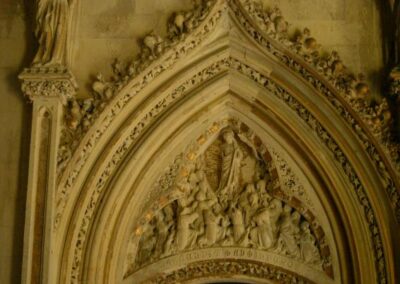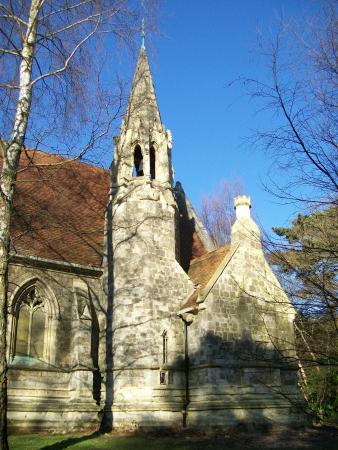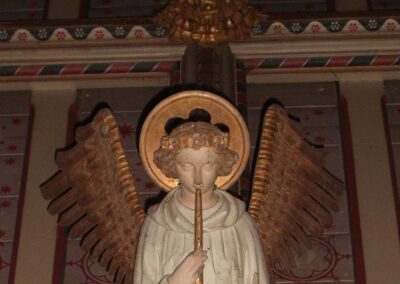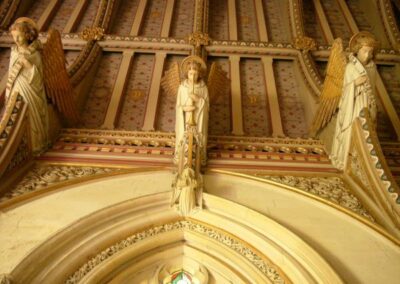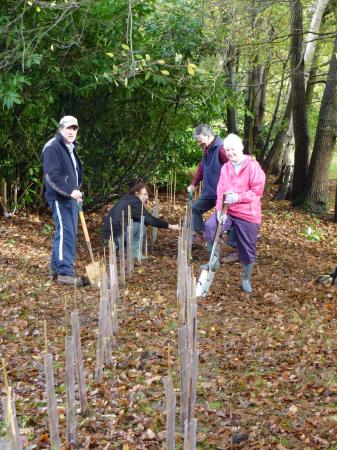Petre Chapel
The chantry chapel was commissioned by the 12th Baron Petre in Gothic Revival style for the burial of his close family members. The Petres have been a celebrated Roman Catholic family of Essex since medieval times.
Saving the Angels phase goes on site
In 2016 detailed surveys of the roof revealed that it was in worse condition that we had feared. Plans had to be revisited and costs rose significantly. Thanks to very generous support from Historic England, the Country Houses Foundation and more than 20 generous individuals work started on site in early October 2017.
Directions
Cars cannot drive up to the chapel, so you should park in Thorndon Country Park ‘second car park’ and walk to the chapel (150 yards). Use the Country Park entrance off ‘The Avenue’.
HCT does not own the access way to the chapel and there is pedestrian access only. Please use the car park and do not drive on the track as this blocks access, damages tree roots – and you are likely to get stuck in soft ground!
In the area
Thorndon Country Park is open throughout the year and has a visitor centre with cafe. The Country Park is very popular in summer, especially at weekends.
Address
Thorndon Park
off Hartswood Road
Brentwood
CM13 3SA
United Kingdom
We welcome group visits, and visitors on Open Days and the burial ground is available for Roman Catholic woodland burials.
The Petre Family
The chapel was built as the mortuary chapel of the Petre family (Petre is pronounced ‘Peter’). The Petres have been a leading family of Essex from medieval times and refused to convert at the Reformation, remaining Roman Catholic recusants. Their former family seat was Thorndon Hall, rebuilt in the eighteenth century as one of the grandest mansions in Essex, designed by James Paine.
Several members of the Petre family are buried in the crypt of the chapel that was built by the family for this purpose. After a major fire the family left Thorndon Hall and the burnt shell was later converted to private apartments. The Petre family seat today is Ingatestone Hall.
The Architect
Dedicated in 1857, the Petre chapel is the work of architect William Wardell (1823-1899). Wardell was a Catholic convert and after a precociously early success as an architect of the Gothic Revival he emigrated to Australia for health reasons. Both St. Patrick’s Cathedral in Melbourne and St. Mary’s Sydney are his work. His client at Thorndon was the 12th Baron Petre.
Architecture
The Petre Chapel is a small but lively composition in ragstone with soft freestone dressings in ‘decorated’ gothic – the style of the mid 14th century. There is an octagonal bellcote rising above the sacristy. Two encircling bands of prayers and leaf decoration in soft limestone run round the building. Sadly this soft stone has not weathered well but on the North side it reads ‘Ego Sum Resurrectio et Vita Qui Credit in me Etiam si Mortuus Fuerit Vivet’ (Translation: I am the resurrection and the life, whoever believes in me, even if he dies, will live’).
Inside, the roof is gloriously decorated with gilded angels on the hammer-beams and richly painted. Stations of the Cross are set in the walls.
The Chapel is one of Essex’s miniature treasures and the present Lord Petre gifted the chapel to HCT in 2010 since when we have raised funds for restoration. Initial repairs and the first stages of restoration are now complete and have secured the structure so it is safe for supervised visits – but there is much to do.
Third Earl of Derwentwater
As well as several Lords Petre and their close family, the crypt holds the remains of the third Earl of Derwentwater who in 1716 was executed in the Tower of London for Treason, for his role in the Jacobite uprising. The Earl’s body was recovered from the executioner by well-connected Catholic supporters and in the 19th century Lord Petre allowed re-interment of the Earl’s remains at his family chantry chapel at Thorndon Park. This ensured the remains were in ground consecrated by a Catholic bishop; and it associated the Petre family with a man widely regarded as a Catholic martyr.
The Chapel is one of Essex’s miniature treasures but has been a source of concern for many years owing to poor condition and vandalism. Lord Petre gifted the chapel to HCT in 2010 since when pro-active management by HCT and co-operation with the Country Park team mean this is a thing of the past. HCT has undertaken the first two stages of restoration – but there is much yet to do.
HCT secured generous grants from Historic England and the Country Houses Foundation for initial urgent repairs to belfry, spire and stonework, completed in 2015.
The roof was repaired in 2018 and the magnificent carved angels to the false hammer beam ceiling were repaired and repainted. The external stone work was also repointed.
The chapel is available for pre-arranged group visits but cannot be hired for events.

